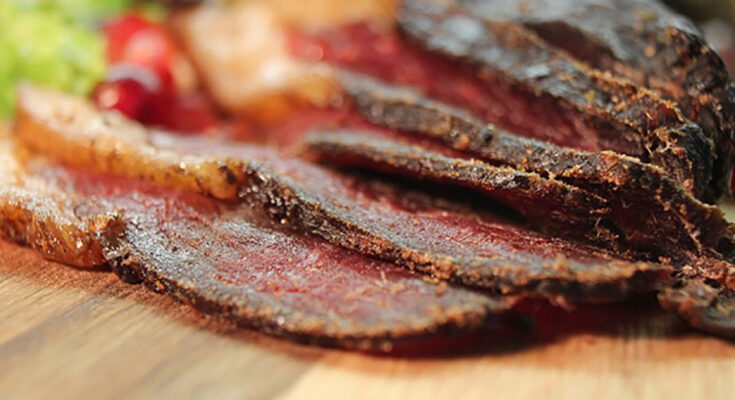Venison Jerky Recipe: There’s something incredibly satisfying about making your own jerky—especially when it’s made from wild game like venison. Whether you’re an avid hunter or just stumbled across some deer meat, this step-by-step guide will walk you through the process of crafting flavorful, protein-packed venison jerky right in your own kitchen. No preservatives, no junk—just delicious, homemade jerky you can be proud of.
Why Make Jerky at Home?
Store-bought jerky is convenient, but it comes with drawbacks—preservatives, artificial flavors, and often, a steep price tag. Making jerky at home not only saves money but also gives you full control over ingredients and flavors. You can dial in the spice level, tweak the sweetness, and experiment with bold herbs and seasonings.
Plus, homemade jerky is a fantastic way to use up venison from hunting season. It reduces waste, and since jerky has a long shelf life, it’s an ideal snack for road trips, hiking adventures, or just nibbling between meals.
Health Benefits of Venison
Venison is one of the leanest red meats available. It’s rich in protein, low in fat, and packed with iron and B vitamins. Compared to beef, venison has fewer calories and less cholesterol, making it a smarter choice for anyone watching their diet. When turned into jerky, it becomes a portable, high-protein snack that fits perfectly into paleo, keto, and low-carb lifestyles.
Choosing the Right Cut of Venison
Best Cuts for Jerky
The key to great jerky lies in choosing the right cut of meat. Not all parts of the deer are created equal when it comes to drying and preserving. The best cuts for jerky are lean, with minimal connective tissue. Popular choices include:
- Top Round
- Bottom Round
- Eye of Round
- Sirloin Tip
- Backstrap (if you’re feeling generous)
Fat doesn’t dehydrate well and can cause spoilage, so you want to avoid marbled cuts or anything with sinew.
Trimming and Preparation Tips
Before you start slicing, make sure your meat is trimmed of all fat and silver skin. A pro tip: slightly freeze the venison for 1-2 hours before slicing. This makes it firmer and easier to cut into uniform strips.
When slicing, go either against the grain for a tender bite or with the grain for a chewier texture—totally depends on your preference. Try to keep your slices about 1/4 inch thick for even drying.
Essential Tools and Ingredients
Must-Have Equipment
While jerky can be made using a simple oven, investing in the right tools makes the process easier and more consistent. Here’s what you’ll need:
- Sharp knife or meat slicer
- Large mixing bowls
- Dehydrator or oven with a low-temperature setting
- Zip-top bags or glass containers (for marinating)
- Cooling racks or jerky trays
Optional but helpful:
- Vacuum sealer for long-term storage
- Meat thermometer for checking internal temperature
Key Ingredients for Flavor
Your jerky flavor is only as good as your marinade. A classic jerky marinade usually includes:
- Soy sauce
- Worcestershire sauce
- Brown sugar or honey
- Black pepper
- Garlic powder
- Onion powder
- Liquid smoke (for that smoky taste)
- Red pepper flakes or hot sauce (for heat)
Want to go next level? Add crushed juniper berries, smoked paprika, or a splash of bourbon.
Preparing the Marinade
Ingredients List
Here’s a simple and delicious base marinade recipe for 2 pounds of venison:
- 1/2 cup soy sauce
- 1/4 cup Worcestershire sauce
- 2 tablespoons brown sugar
- 1 teaspoon onion powder
- 1 teaspoon garlic powder
- 1 teaspoon black pepper
- 1/2 teaspoon crushed red pepper (optional)
- 1/2 teaspoon liquid smoke (optional but recommended)
Feel free to customize to your taste—sweeter, spicier, or saltier.
Mixing the Marinade
In a large mixing bowl, combine all the marinade ingredients and stir well until everything is dissolved. Place your sliced venison into a zip-top bag or container, pour in the marinade, and make sure every piece is fully submerged.
Massage the bag a little to evenly coat all the slices. Then pop it in the fridge and let the flavors soak in.
Marinating the Venison
How Long to Marinate
The longer your venison soaks, the more flavor it will absorb. A minimum of 12 hours is ideal, but 24 hours is better. Some folks even go up to 48 hours for a deep, intense flavor profile.
Be sure to shake or flip the bag every few hours so that the meat marinates evenly.
Tips for Deep Flavor
- Use a vacuum-sealed container to pull the marinade deeper into the meat.
- Add a dash of vinegar or citrus juice to tenderize tougher cuts.
- Don’t reuse leftover marinade unless you boil it first—it’s raw meat juice!
Dehydrating the Jerky
Using a Dehydrator
When it comes to making jerky, a dehydrator is your best friend. It circulates warm air evenly around the meat, drying it out slowly and thoroughly. Once your venison slices are done marinating, pat them dry with paper towels to remove excess liquid—this helps them dry faster and gives a better texture.
Lay the strips in a single layer on the dehydrator trays, making sure they don’t touch or overlap. Set your dehydrator to 160°F (71°C)—the USDA-recommended temperature for jerky made from game meat. Depending on thickness, drying time can range from 4 to 8 hours. Check periodically, rotating trays if needed for even drying.
You’ll know the jerky is done when it bends but doesn’t break, and no moisture seeps out when you press on it.
Oven Drying Method
No dehydrator? No problem. Your kitchen oven can still do the job. Preheat your oven to 170°F (or as low as it goes). Place the venison slices on a wire rack set over a baking sheet to catch drips. Keep the oven door slightly ajar—this allows moisture to escape and helps air circulate.
Oven-drying will take about the same time, possibly a little longer. Be sure to flip the strips halfway through. Using a fan in the kitchen can also help with airflow and speed up the process. Again, test doneness by bending a piece—it should be firm but pliable.
Checking for Doneness
Texture and Moisture Tips
Perfect jerky should have a leathery texture. It’s dry but not bone-dry. It should bend without snapping, and the surface should not feel sticky or greasy. If the jerky cracks or shatters, it’s overdone. If it’s squishy or wet, it’s not done yet.
The best way to test? Tear a piece in half—look for visible white fibers and an even, dry interior. Still not sure? Try tasting a piece. If it’s chewy, flavorful, and not soggy, you’ve nailed it.
For extra safety, you can heat the finished jerky in the oven at 275°F for 10 minutes to kill off any remaining bacteria. This is especially important when using wild game.
Storing Your Venison Jerky
Best Storage Methods
Jerky needs to be stored properly to maintain its taste and shelf life. If you plan to eat it within a week, a sealed zip-top bag or airtight container at room temperature is fine. For longer storage, refrigerate or freeze it.
For the longest shelf life, vacuum-sealing is ideal. This keeps air and moisture out, extending freshness for months. Store vacuum-sealed jerky in a cool, dark place, or freeze it for up to a year without losing flavor.
Shelf Life Expectations
- Room Temp (airtight): 1–2 weeks
- Refrigerated (sealed): 1–2 months
- Frozen (vacuum-sealed): 6–12 months
Always label your jerky with the date so you know how long it’s been stored. And don’t forget to check for spoilage—mold, odd smells, or slimy textures are signs to toss it out.
Venison Jerky Recipe Variations
Spicy Venison Jerky
Love heat? Crank it up with a spicy marinade. Here’s a twist to try:
- 1/2 cup soy sauce
- 1/4 cup apple cider vinegar
- 1 tablespoon hot sauce (like Tabasco or Sriracha)
- 1 teaspoon cayenne pepper
- 1 teaspoon smoked paprika
- 1 teaspoon garlic powder
- 1/2 teaspoon black pepper
This fiery mix will give your jerky a bold kick without overpowering the natural venison flavor.
Sweet Teriyaki Style
Prefer something sweet and savory? This teriyaki-style version hits the spot:
- 1/2 cup teriyaki sauce
- 1/4 cup pineapple juice
- 2 tablespoons brown sugar
- 1 teaspoon grated ginger
- 1 teaspoon garlic powder
- Dash of sesame oil
The pineapple helps tenderize the meat, while the sweetness balances the salt. Add sesame seeds before drying for extra crunch and flavor.
Tips for the Perfect Jerky Every Time
- Use lean meat only: Fat leads to spoilage.
- Cut uniform strips: Even thickness ensures consistent drying.
- Don’t rush the marinating process: More time equals more flavor.
- Dry thoroughly: Jerky should be bendable, not brittle.
- Store smart: Use vacuum sealing or freezing for long-term storage.
Little tweaks make a big difference. Keep a jerky journal to track what works best for your taste buds.
Mistakes to Avoid When Making Jerky
Making venison jerky at home is rewarding, but there are a few common pitfalls that can ruin the final product. Let’s walk through the most frequent mistakes so you can avoid them and keep your jerky game strong.
1. Not trimming the fat properly: Fat doesn’t dry well. It can go rancid quickly and spoil your entire batch. Always take the time to meticulously trim off every bit of visible fat and silver skin before marinating your venison.
2. Inconsistent slicing: Uneven slices dry at different rates. That means some pieces may be overdone while others are still too moist. Aim for uniform thickness—about 1/4 inch—for best results. Using a meat slicer can help maintain consistency.
3. Not marinating long enough: Good jerky is all about flavor infusion. A quick 2-3 hour soak won’t cut it. You need at least 12 hours, ideally 24, for the marinade to penetrate the meat fully.
4. Overlapping slices during drying: Each piece of jerky needs its own space for air to circulate. Overlapping or crowding the trays leads to uneven drying, which can result in spoilage or soggy spots.
5. Improper storage: Even perfectly made jerky won’t last if not stored correctly. Exposure to air and moisture quickly degrades flavor and safety. Always store jerky in airtight containers, use vacuum sealing when possible, and refrigerate or freeze for long-term storage.
Avoiding these mistakes ensures your jerky comes out just right—every single time.
Venison Jerky Nutritional Breakdown
Venison jerky isn’t just delicious—it’s also incredibly nutritious. It’s a high-protein, low-fat snack that fits into nearly every diet, from keto to paleo to low-carb meal plans. Here’s a general breakdown of the nutritional values per 1-ounce serving of homemade venison jerky:
| Nutrient | Amount |
|---|---|
| Calories | 80-100 |
| Protein | 10-14 grams |
| Total Fat | 1-2 grams |
| Saturated Fat | <1 gram |
| Carbohydrates | 2-5 grams |
| Sugars | 1-3 grams |
| Sodium | 300-600 mg |
| Cholesterol | 20-30 mg |
These values vary depending on the ingredients used in the marinade. For example, sweet marinades with brown sugar or honey will increase the sugar and carb count. Likewise, soy sauce-heavy recipes will be higher in sodium. But overall, venison jerky remains one of the healthiest jerky options available—especially compared to store-bought versions loaded with preservatives and additives.
FAQs about Venison Jerky Recipe
Q1: Can I use frozen venison to make jerky?
Absolutely! Just make sure it’s completely thawed before slicing and marinating. Freezing slightly before slicing can even make the meat easier to cut evenly.
Q2: How long does homemade venison jerky last?
Stored at room temperature in an airtight container, it lasts about 1-2 weeks. Refrigerated, it can last up to 2 months. For maximum shelf life, vacuum-seal and freeze for up to a year.
Q3: Do I need to cook the jerky before dehydrating it?
Not necessarily, but it’s wise to preheat the jerky to 160°F before or after drying for food safety, especially when using wild game. This ensures harmful bacteria are killed.
Q4: Can I make jerky without a dehydrator?
Yes! Your oven works just fine. Keep the door slightly open and use a wire rack over a baking sheet for airflow. Just monitor closely to avoid over-drying.
Q5: What can I do if my jerky is too salty or spicy?
Dilute your marinade next time or rinse the strips briefly after marinating. Also, balancing with sweet or acidic elements like honey or lemon juice can help mellow the flavor.
Conclusion
Making venison jerky at home is more than a culinary project—it’s a skill that turns simple meat into a delicious, long-lasting, and healthy snack. Whether you’re stocking up for a camping trip or just want something hearty and wholesome to nibble on, venison jerky delivers on flavor, nutrition, and satisfaction.
With the right cut of meat, a flavorful marinade, and a little patience during the drying process, anyone can master this art. Now that you know all the tricks, tips, and variations, it’s time to put on your apron, grab some venison, and start slicing. Your perfect batch of homemade jerky is just a few steps away.
Happy jerky making!



